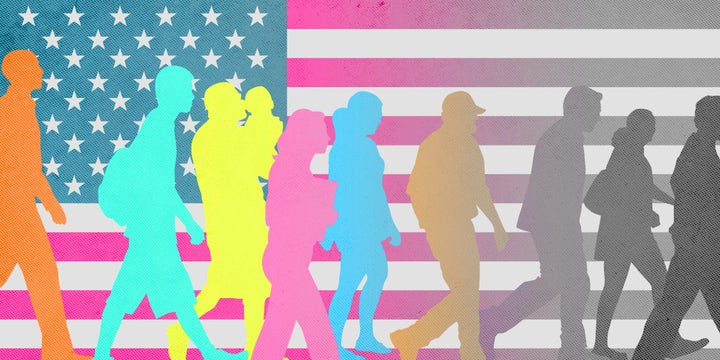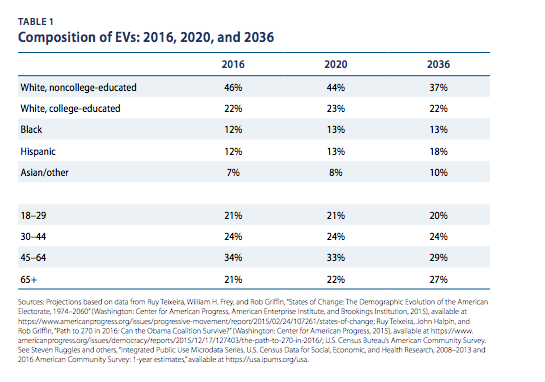
America’s electorate is growing more diverse. By the next presidential election, racial minorities will exceed 40 percent of the eligible electorate in six states, according to a report released in April by a consortium of think tanks. By 2036, a dozen states will pass that mark.
At the same time, the share of states whose electorates are more than four-fifths white is predicted to drop steadily, from 23 in the next presidential election to only 11 by the year 2036.
Nationwide, white voters without a college education are expected to make up a dwindling ― though still significant ― share of the eligible electorate, dropping from 46 percent in the last presidential election to just 37 percent by the year 2036. The electorate is also aging, with voters above the age of 65 making up an increasing slice.
The report, titled “States of Change,” was produced the Bipartisan Policy Center, the Brookings Institution, PRRI and the progressive Center for American Progress.

“Demographics are not destiny,” authors Rob Griffin, Ruy Teixeira and William H. Frey write, “but steady and predictable changes to the electorate play an important role in defining the landscape of American elections.”
The impact these changes have at the polls in 2020 and future elections depends both on which groups actually turn out to vote and how strongly traits like race and education hold together as voting blocs.
The report lays out more than 30 possible scenarios for upcoming elections. In several, voting patterns stay the same as in past elections, with the only change coming from the overall makeup of the electorate. Generally, as the electorate becomes more diverse, that would shift the momentum increasingly toward Democrats in future years. But especially in the short term, there’s still room for variance. For instance, if the unusually high share of third-party voters in the last election “return home” to their parties in the next presidential contest, but 2016′s voting patterns are otherwise repeated by the 2020 electorate, the country could end with an Electoral College tie.
In other scenarios, racial minorities begin to turn out at the same rate as white voters ― also likely a boon for Democrats, unless minority groups begin shifting toward the GOP. In still other versions of the future, if white voters without college degrees swing further toward the GOP, the party could take a narrow popular vote victory and a comfortable Electoral College win.
Republicans can find immediate success by targeting non-college-educated whites. But going forward, as that group shrinks, the party would eventually lose in the Electoral College. If the GOP doesn’t also reach out to Hispanics and Asians, the report concludes, they “risk putting themselves into a box where they become ever more dependent on a declining white population — particularly its older segment.”
Segments of the GOP expressed those very concerns prior to President Donald Trump’s victory. Following Mitt Romney’s 2012 loss, the party’s autopsy argued that Republicans needed to reach out to minorities and women to survive. In 2015, discussing a previous year’s report on demographic change, a pollster for Republicans like Sen. Marco Rubio (R-Fla.) argued that the party would need to attract a record percentage of minorities to win the presidency in 2016.
In retrospect, that alarm looks premature. And as the most recent report finds, the GOP still has paths to victory that don’t include a broader tent. The underlying demographic shifts, though, would seem to constrict the party’s options going forward.
“Taken together, the States of Change projections for the Republican Party are reasonably dire,” Sean Trende, a senior election analyst for RealClearPolitics, noted in a review of the scenarios included in the report. But he added later, “Simply put, if demographics were the overwhelming factor that many suggest they are, then a candidate like Trump ought not to have been able to win in the least-white electorate on record. Yet he did win — and likely won in part as a reaction to these demographic changes.”

A number of the report’s scenarios end with Republicans again winning the Electoral College while failing to capture the popular vote. Another split of that kind could be demotivating for voters, especially on the Democratic side, Democratic pollster Anna Greenberg said at a recent panel discussing the report.
Greenberg noted that she’d heard from many young voters in post-election focus groups that they felt democratic participation was futile: “If you think your vote doesn’t matter, then why go out and vote?”
The span of plausible scenarios in which a given party could pull off a presidential win also lays bare ongoing arguments within Democratic and Republican ranks about their parties’ futures. For instance, it raises the question to what extent Democrats should focus on winning back white, non-college-educated voters from the GOP, versus turning out young and minority voters who are already predisposed to vote Democratic but are not guaranteed to show up at the ballot box.
“I’ve always taken the view that political coalitions are like water balloons,” Trende said at the same panel discussion. “You step down on one side and another side pops up. And I think that is a real problem for the Democrats going forward. You can try to tend to various parts of the coalition, but inevitably, you have a message that dominates.”
Even as demographics seem to give Democrats a growing advantage, the report concludes, winning the Electoral College will likely require a “delicate balancing act” between the dual goals of “intensifying their support among voters of color and improving their margins among white, particularly white non-college-educated, voters.”
“It really hits home the challenge for what the progressive narrative is for Democrats,” Greenberg said, pointing to winning scenarios that wouldn’t require the party to improve on Hillary Clinton’s 2016 numbers with working-class whites. “You can easily win in the future solely on the votes of minority voters, white college-educated [voters], especially women, and not ever talk to the white working class. ... So tactically, that’s a fine strategy, but philosophically for the Democratic Party, not such a fine strategy.”
